Pioneer MVH-8250, MVH-8250BT Manual

MEDIA CENTER RECEIVER
RECEPTOR Y CENTRO DE COMUNICACIONES
MEDIA CENTER RECEIVER
MVH-8250BT MVH-8250
(B) Português Español English
Operation Manual Manual de instrucciones Manual de operação


 Contents
Contents
Thank you for purchasing this PIONEER product.
To ensure proper use, please read through this manual before using this product. It is especially important that you read and observe WARNINGs and CAUTIONs in this manual. Please keep the manual in a safe and accessible place for future reference.
Precautions |
|
|
|
|
IMPORTANT SAFEGUARDS |
4 |
|||
To ensure safe driving |
4 |
|
||
To avoid battery exhaustion |
5 |
|||
Before You Start |
|
|
|
|
About this unit |
6 |
|
|
|
Operating environment |
6 |
|
||
In case of trouble |
6 |
|
|
|
Resetting the microprocessor 6 |
||||
Demo mode 6 |
|
|
|
|
About this manual |
6 |
|
|
|
Operating this unit |
|
|
||
Head unit 7 |
|
|
|
|
Remote control |
7 |
|
|
|
Basic Operations |
8 |
|
|
|
Use and care of the remote control 9 |
||||
Basic menu operations |
9 |
|
||
– Menu operations identical for function |
||||
settings/audio adjustments/initial |
||||
settings/lists |
10 |
|
|
|
Customizing menus 10 |
|
|
|
||
– |
Canceling a Registered Menu |
10 |
|
||
About guide information |
10 |
|
|
||
Using Bluetooth telephone 11 |
|
|
|||
– |
Setting up for hands-free phoning |
11 |
|||
– |
Basic Operations |
11 |
|
|
|
Radio |
12 |
|
|
|
|
– |
Basic Operations |
12 |
|
|
|
– |
Storing and recalling stations |
12 |
|
||
– |
Function settings |
12 |
|
|
|
Playing moving images |
13 |
|
|
||
– |
Basic Operations |
13 |
|
|
|
– |
Selecting and playing files from the |
||||
|
name list |
14 |
|
|
|
– |
Browsing for a video on the iPod |
14 |
|||
– |
Playing DivXâ VOD content |
14 |
|
||
– |
Function settings |
15 |
|
|
|
Playing audio |
17 |
|
|
|
|
– |
Basic Operations |
17 |
|
|
|
||
– |
Selecting and playing files/tracks from |
||||||
|
the name list |
18 |
|
|
|
|
|
– |
Browsing for a song on the iPod |
18 |
|||||
– |
Function settings |
18 |
|
|
|
||
Playing still images |
20 |
|
|
|
|
||
– |
Basic Operations |
20 |
|
|
|
||
– |
Selecting and playing files from the |
||||||
|
name list |
21 |
|
|
|
|
|
– |
Function settings |
21 |
|
|
|
||
– |
Introduction of operations for playback |
||||||
|
of still images as a slideshow 22 |
|
|||||
Bluetooth Telephone |
23 |
|
|
|
|||
– |
Connection menu operation |
23 |
|
||||
– |
Phone menu operation |
24 |
|
|
|||
– |
Function and operation |
25 |
|
|
|||
Audio Adjustments |
25 |
|
|
|
|
||
System settings |
27 |
|
|
|
|
|
|
Entertainment settings |
28 |
|
|
|
|||
– |
Customizing the illumination color 28 |
||||||
Initial Settings |
29 |
|
|
|
|
|
|
– |
Auto EQ (auto-equalizing) 30 |
|
|||||
Other Functions |
32 |
|
|
|
|
|
|
– |
Using an AUX source |
32 |
|
|
|||
– |
Switching the display indication |
32 |
|||||
Detailed instructions |
|
|
|
|
|||
Changing the wide screen mode |
33 |
|
|||||
Setting the DivX subtitle file |
33 |
|
|
||||
Setting the aspect ratio |
33 |
|
|
|
|||
Displaying the DivXâ VOD registration |
|
||||||
code 34 |
|
|
|
|
|
|
|
Displaying the deactivation code |
34 |
|
|||||
Changing the picture adjustment |
34 |
|
|||||
Additional Information |
|
|
|
|
|||
Troubleshooting |
35 |
|
|
|
|
|
|
Error messages |
35 |
|
|
|
|
|
|
Understanding auto EQ error messages |
38 |
||||||
Indicator list 38 |
|
|
|
|
|
||
 2
2 En
En

 Contents
Contents
English
Handling guideline 39
Compressed audio/video compatibility (USB,
SD) 40 |
|
|
iPod compatibility 41 |
|
|
Sequence of audio files 41 |
|
|
Using the display correctly |
42 |
|
– |
Handling the display |
42 |
– |
Liquid crystal display (LCD) screen 42 |
|
– |
LED (light-emitting diode) |
|
|
backlight 43 |
|
– Fluorescent tube 43 Copyright and trademark 43 Specifications 45
En  3
3
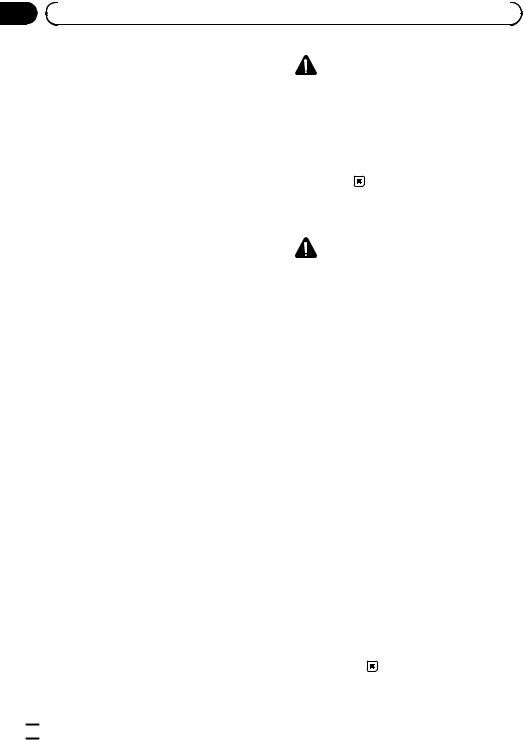
Section |
|
|
|
|
||
01 |
Precautions |
|
|
|
||
|
IMPORTANT SAFEGUARDS |
|
WARNING |
|||
|
Please read all of these instructions regarding |
|
||||
|
! Do not attempt to install or service your |
|||||
|
your display and retain them for future refer- |
|
display by yourself. Installation or servi- |
|||
|
ence. |
|
cing of the display by persons without |
|||
1 |
Read this manual fully and carefully be- |
|
training and experience in electronic |
|||
|
|
fore operating your display. |
|
equipment and automotive accessories |
||
2 |
Keep this manual handy as a reference for |
|
may be dangerous and could expose you |
|||
|
|
operating procedures and safety informa- |
|
to the risk of electric shock or other |
||
|
|
tion. |
|
hazards. |
||
3 |
Pay close attention to all warnings in this |
|
|
|
||
|
|
manual and follow the instructions care- |
|
|
|
|
|
|
fully. |
To ensure safe driving |
|||
4 |
Do not allow other persons to use this sys- |
|||||
|
|
|
||||
|
|
tem until they have read and understood |
|
WARNING |
||
|
|
the operating instructions. |
! |
LIGHT GREEN LEAD AT POWER CON- |
||
5 |
Do not install the display where it may (i) |
|
NECTOR IS DESIGNED TO DETECT |
|||
|
|
obstruct the driver’s vision, (ii) impair the |
|
|||
|
|
|
PARKED STATUS AND MUST BE CON- |
|||
|
|
performance of any of the vehicle’s oper- |
|
|||
|
|
|
NECTED TO THE POWER SUPPLY SIDE |
|||
|
|
ating systems or safety features, includ- |
|
|||
|
|
|
OF THE PARKING BRAKE SWITCH. IM- |
|||
|
|
ing air bags, hazard lamp buttons or (iii) |
|
|||
|
|
|
PROPER CONNECTION OR USE OF |
|||
|
|
impair the driver’s ability to safely oper- |
|
|||
|
|
|
THIS LEAD MAY VIOLATE APPLICABLE |
|||
|
|
ate the vehicle. |
|
|||
|
|
|
LAW AND MAY RESULT IN SERIOUS IN- |
|||
6 |
Do not operate this display if doing so in |
|
||||
|
JURY OR DAMAGE. |
|||||
|
|
any way will divert your attention from |
|
|||
|
|
! |
To avoid the risk of damage and injury and the |
|||
|
|
the safe operation of your vehicle. Always |
|
potential violation of applicable laws, this unit |
||
|
|
observe safe driving rules and follow all |
|
|||
|
|
|
is not for use with video that is visible to the |
|||
|
|
existing traffic regulations. If you experi- |
|
|||
|
|
|
driver. |
|||
|
|
ence difficulty in operating the system or |
|
|||
|
|
! |
To avoid the risk of accident and the potential |
|||
|
|
reading the display, park your vehicle in a |
|
violation of applicable laws, no viewing of |
||
|
|
safe location and make necessary adjust- |
|
|||
|
|
|
front seat video should ever occur while the |
|||
|
|
ments. |
|
|||
|
|
|
vehicle is being driven. |
|||
7 |
Please remember to wear your seat belt at |
|
||||
! |
In some countries or states the viewing of |
|||||
|
|
all times while operating your vehicle. If |
|
images on a display inside a vehicle even by |
||
|
|
you are ever in an accident, your injuries |
|
|||
|
|
|
persons other than the driver may be illegal. |
|||
|
|
can be considerably more severe if your |
|
|||
|
|
|
Where such regulations apply, they must be |
|||
|
|
seat belt is not properly buckled. |
|
|||
|
|
|
obeyed. |
|||
8 |
Never use headphones while driving. |
|
||||
When you attempt to watch a video image |
||||||
9 |
To promote safety, certain functions are |
|||||
|
|
disabled unless the parking brake is on, |
while driving, the warning Viewing of front |
|||
|
|
and the vehicle is not in motion. |
seat video source while driving is strictly |
|||
10 |
Never set the volume of your display so |
prohibited. will appear on the front display. |
||||
|
|
high that you cannot hear outside traffic |
To watch a video image on the front display, |
|||
|
|
and emergency vehicles. |
park your vehicle in a safe place and apply the |
|||
|
|
|
parking brake. |
|||
 4
4 En
En

 Precautions
Precautions
To avoid battery exhaustion
Keep the vehicle engine running when using this unit to avoid draining the battery power.
!When no power is supplied to this unit, such as when the vehicle battery is being replaced, the microcomputer of this unit returns to its initial condition. We recommend that you transcribe the audio adjustment data.
 WARNING
WARNING
Do not use with vehicles that do not feature an ACC position.
Section
01
English
En  5
5
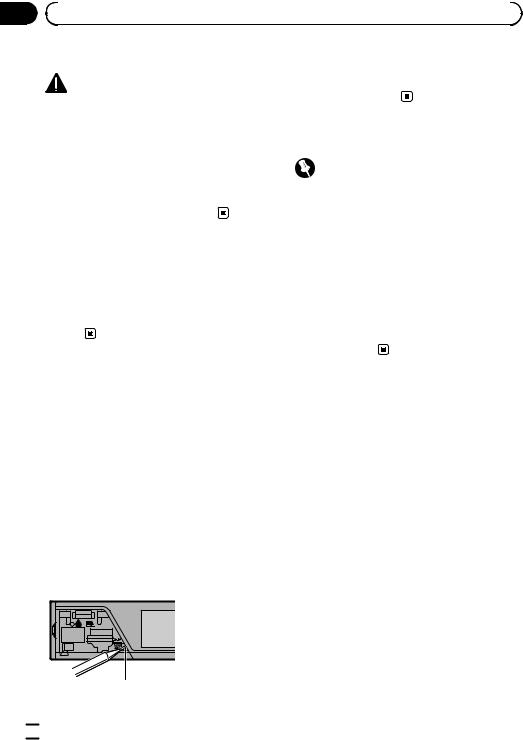
Section |
|
|
|
|
02 |
|
Before You Start |
|
|
|
About this unit |
1 Remove the front panel. |
||
|
|
CAUTION |
2 Press RESET with a pen tip or other |
|
|
|
pointed instrument. |
||
|
! Do not allow this unit to come into contact |
|||
|
|
|
||
|
|
with liquids. Electrical shock could result. |
|
|
|
|
Also, damage to this unit, smoke, and over- |
Demo mode |
|
|
|
heating could result from contact with liquids. |
||
|
! Always keep the volume low enough to hear |
Important |
||
|
|
outside sounds. |
||
|
|
|
|
|
|
! Avoid exposure to moisture. |
Failure to connect the red lead (ACC) of this unit |
||
|
! If the battery is disconnected or discharged, |
to a terminal coupled with ignition switch on/off |
||
|
|
any preset memory will be erased. |
operations may lead to battery drain. |
|
|
|
|
The demo automatically starts when the igni- |
|
|
Operating environment |
tion switch is set to ACC or ON while the unit |
||
|
is turned off. Turning off the unit does not can- |
|||
|
This unit should be used within the tempera- |
|||
|
cel demo mode. To cancel the demo mode, op- |
|||
|
ture ranges shown below. |
erate the function in the initial setting menu. |
||
|
Operating temperature range: -10 °C to +60 °C |
Operating the demo while the ignition switch |
||
|
EN300328 ETC test temperature: -20 °C and |
is set to ACC may drain battery power. |
||
|
+55 °C |
Refer to Demonstration (demo display set- |
||
|
|
|
ting) on page 29. |
|
In case of trouble
Should this product fail to operate properly, please contact your dealer or nearest authorized Pioneer Service Station.
Resetting the microprocessor
The microprocessor must be reset in the following situations:
!Before using this unit for the first time after installation
!If the unit fails to operate properly
!When strange or incorrect messages appear on the display
About this manual
This manual describes operations of both MVH-8250BT and MVH-8250. Only MVH8250BT features Bluetooth functions, so the explanations for those functions do not apply to MVH-8250.
In the following instructions, USB memories, USB portable audio players, and SD memory cards are collectively referred to as “external storage devices (USB, SD).” If only USB memories and USB portable audio players are indicated, they are collectively referred to as “USB storage devices.”
In this manual, iPod and iPhone will be referred to as “iPod”.
RESET button
 6
6 En
En
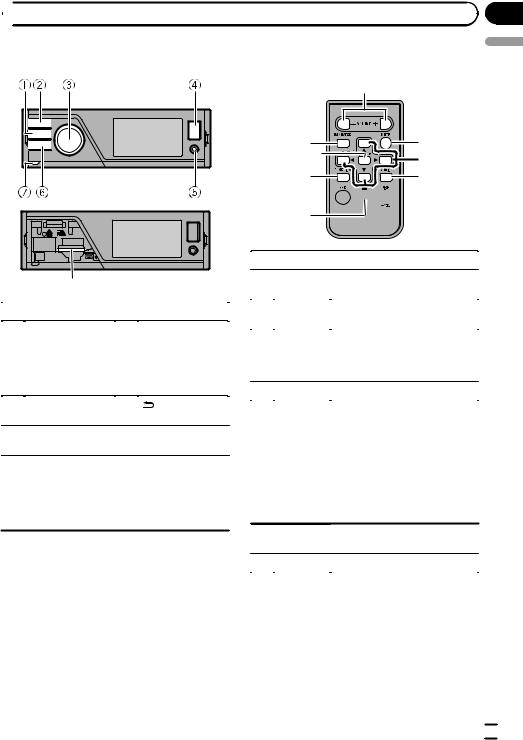
 Operating this unit
Operating this unit
Head unit |
Remote control |
Section
03
English
|
Part |
|
Part |
|
|
|
AUX input jack (3.5 |
|
|
|
mm stereo/video |
1 |
HOME |
5 |
jack) |
Microphone input |
|||
|
|
|
jack for auto EQ |
|
|
|
measurement |
|
|
|
|
2 |
SRC/OFF |
6 |
(back/display |
off) |
|||
|
|
|
|
3 |
MULTI-CONTROL |
7 |
Detach button |
|
(M.C.) |
|
|
|
|
|
SD memory card |
|
|
|
slot |
4 |
USB port |
8 |
Remove the front |
panel to access the |
SD memory card slot.
 CAUTION
CAUTION
Use an optional Pioneer USB cable (CD-U50E) to connect the USB audio player/USB memory as any device connected directly to the unit will protrude out from the unit and may be dangerous. Do not use unauthorized products.
|
|
|
|
||
|
||
|
|



|
Part |
Operation |
|
9 |
+/– (VO- |
Press to increase or decrease vo- |
|
|
LUME) |
lume. |
|
a |
MUTE |
Press to mute. Press again to un- |
|
mute. |
|||
|
|
||
|
|
|
|
|
|
Press to perform manual seek |
|
b |
a/b/c/d |
tuning, fast forward, reverse and |
|
track search controls. Also used |
|||
|
|
||
|
|
for controlling functions. |
|
|
|
|
|
c |
AUDIO |
Press to select an audio function. |
|
|
|
|
Press to select different displays for the audio source.
Press to select the basic screen or image screen for the video
source.
d DISP/SCRL ! If the background setting on the entertainment menu is turned off, you can switch between the basic screen and image screen.
e |
e |
Press to pause or resume play- |
|
back. |
|||
|
|
||
|
|
||
f |
FUNCTION Press to select functions. |
||
|
|
|
|
En  7
7

Section
03  Operating this unit
Operating this unit
Part Operation
Press to display the list depending g LIST/ on the source.
ENTER While in the operating menu, press to control functions.
Press to select among three FM bands and one AM band.
When playing external storage devices containing a mixture of various media file types, press to switch between media file types
h BAND/ESC
to play.
Music (compressed audio)— Video (DivX video files)—Photo (JPEG picture files)
Press to return to the ordinary display from the list/function menu. Press to cancel the initial setting menu.
Basic Operations
 Important
Important
!Handle gently when removing or attaching the front panel.
!Avoid subjecting the front panel to excessive shock.
!Keep the front panel out of direct sunlight and high temperatures.
!To avoid damage to the device or vehicle interior, remove any cables and devices attached to the front panel before detaching it.
Removing the front panel to protect your unit from theft
1Press the detach button to release the front panel.
2Grab the front panel and remove.
3Always keep the detached front panel in a protection device such as a protection case.
Re-attaching the front panel
1Slide the front panel up until it clicks.
The front panel and the head unit are connected on the upper side. Make sure that the front panel has been properly connected to the head unit.
2Press the lower side of the front panel until it is firmly seated.
If you can’t attach the front panel to the head unit successfully, try again. However, forcing the front panel into place may result in damage.
Turning the unit on
1 Press SRC/OFF to turn the unit on.
Turning the unit off
1 Press SRC/OFF and hold until the unit turns off.
Selecting a source
1Press SRC/OFF to cycle between:
Radio (tuner)—USB (USB storage device)/iPod (iPod connected using USB input)—SD (SD memory card)—AUX (AUX)
Adjusting the volume
1 Turn M.C. to adjust volume.
 Note
Note
When this unit’s blue/white lead is connected to the vehicle’s auto-antenna relay control terminal, the vehicle’s antenna extends when this unit’s source is turned on. To retract the antenna, turn the source off.
 8
8 En
En
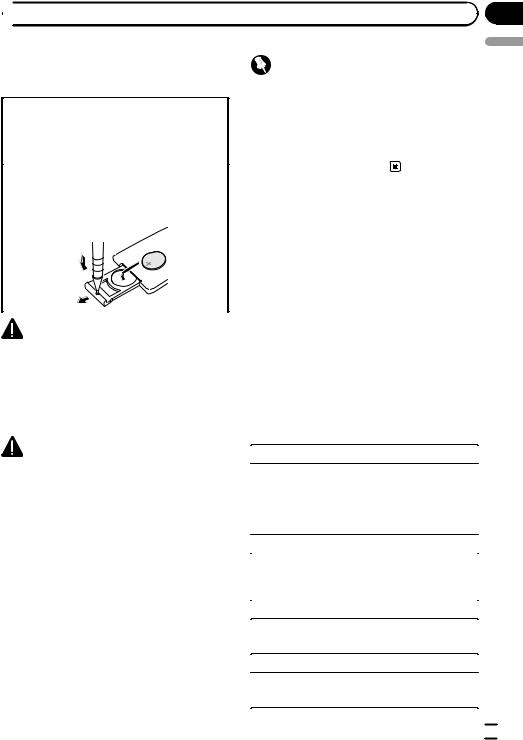
 Operating this unit
Operating this unit
Use and care of the remote |
Important |
|
control |
! Do not store the remote control in high tem- |
|
|
peratures or direct sunlight. |
|
Using the remote control |
||
! The remote control may not function properly |
||
1 Point the remote control in the direction of the |
||
in direct sunlight. |
||
front panel to operate. |
||
! Do not let the remote control fall onto the |
||
When using for the first time, pull out the film |
||
protruding from the tray. |
floor, where it may become jammed under the |
|
|
brake or accelerator pedal. |
|
Replacing the battery |
||
|
1Slide the tray out on the back of the remote control.
2 Insert the battery with the plus (+) and minus (–) |
Basic menu operations |
||
poles aligned properly. |
|||
|
|
||
|
You can operate source selection, list function, |
||
|
audio adjustment, etc., using HOME. |
||
|
1 Press HOME. |
||
|
2 Push M.C. up or down to change the |
||
|
menu option. |
||
WARNING |
Home (home menu)—Custom (custom |
||
menu)—Phone (phone menu) |
|||
! Keep the battery out of the reach of children. |
# The phone menu is available only for MVH- |
||
Should the battery be swallowed, consult a |
8250BT. |
||
doctor immediately. |
3 Turn M.C. to select the menu option. |
||
! Batteries (battery pack or batteries installed) |
|||
must not be exposed to excessive heat such |
After selecting, perform the following proce- |
||
as sunshine, fire or the like. |
dures. |
||
|
Home (home menu) |
||
CAUTION |
|
|
|
|
Source (selecting a source) |
||
! Use one CR2025 (3 V) lithium battery. |
|
1 Press M.C. to display the setting mode. |
|
! Remove the battery if the remote control is not |
|
||
used for a month or longer. |
|
2 Use M.C. to select the desired source name. |
|
|
Turn to change the source. Press to select. |
||
! There is a danger of explosion if the battery is |
|
||
|
For the sources you can choose, refer to Selecting |
||
incorrectly replaced. Replace only with the |
|
||
|
a source on the previous page. |
||
same or equivalent type. |
|
||
|
|
||
|
List (operating a list menu) |
||
! Do not handle the battery with metallic tools. |
|
||
! Do not store the battery with metallic objects. |
|
1 Press M.C. to display the list. |
|
! If the battery leaks, wipe the remote control |
|
||
|
Press to display the folder list, file list or preset |
||
completely clean and install a new battery. |
|
channel list depending on the source. |
|
! When disposing of used batteries, comply |
|
|
|
|
Audio (setting an audio menu) |
||
with governmental regulations or environmen- |
|
||
|
|
||
tal public institutions’ rules that apply in your |
|
1 Press M.C. to display the audio menu. |
|
country/area. |
|
Refer to Audio Adjustments on page 25. |
|
|
|
System (setting a system menu) |
|
|
|
1 Press M.C. to display the system menu. |
|
|
|
Refer to System settings on page 27. |
|
|
|
|
|
Section
03
English
En  9
9
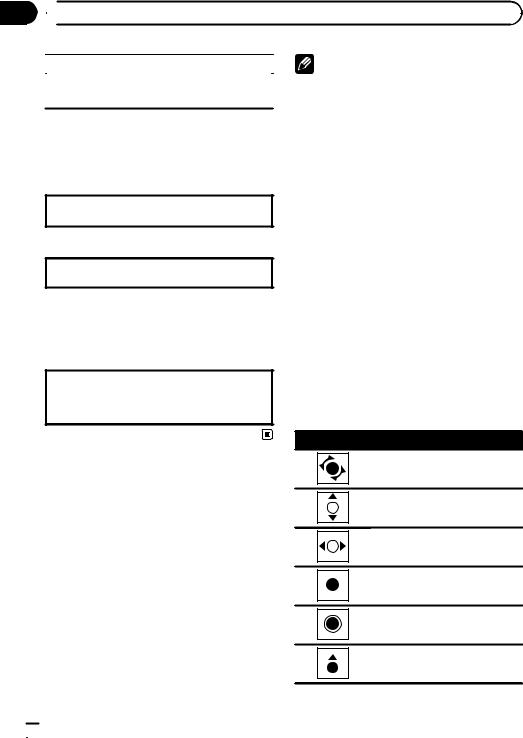
Section
03  Operating this unit
Operating this unit
Entertainment (setting an entertainment menu) |
Note |
|
|
1Press M.C. to display the entertainment menu. Refer to Entertainment settings on page 28.
You can register up to 12 columns.
Custom (custom menu)
You can choose menus within each menu (Audio function menu, etc.) and register them to this custom menu.
Refer to Customizing menus on this page.
The custom menu is displayed.
1 Press M.C. to display the setting mode.
Phone (phone menu)
The phone menu is displayed.
Refer to Phone menu operation on page 24.
Menu operations identical for function settings/audio adjustments/initial settings/lists
Returning to the previous display
Returning to the previous list/category (the folder/category one level higher)
1 Press .
.
Customizing menus
You can register frequently used menu items to a custom menu.
!The menu columns you can register are displayed in circular indicators.
1Display menu columns to register.
2Push and hold M.C. right to register the menu column.
The menu columns you have registered are displayed in large, circular indicators.
3Display the custom menu and choose a registered menu.
Refer to Basic menu operations on the previous page.
Canceling a Registered Menu
1Display the custom menu and choose a registered menu.
Refer to Basic menu operations on the previous page.
2Push and hold M.C. right to cancel the registered menu.
About guide information
This unit displays guide information on how to use M.C. for each function.
1 Display the system menu.
Refer to Basic menu operations on the previous page.
2 Use M.C. to select the Guide Info.
Turn to change the menu option. Press to select.
Guide information is displayed.
Operation
Turn M.C.
Push M.C. up or down.
Push M.C. left or right.
Press M.C.
Press and hold M.C.
Push M.C. up.
 10
10 En
En

|
Section |
Operating this unit |
03 |
Operation
Push M.C. down.
Push and hold M.C. up.
# Press M.C. to display the next page.
Using Bluetooth telephone
This function is available only for MVH-8250BT.
 Important
Important
!Since this unit is on standby to connect with your cellular phone via Bluetooth wireless technology, using it without the engine running can drain the battery power.
!Operations may vary depending on the kind of cellular phone.
!Advanced operations that require attention such as dialing numbers on the monitor, using the phone book, etc., are prohibited while driving. Park your vehicle in a safe place when using these advanced operations.
Setting up for hands-free phoning
Before you can use the hands-free phoning function you must set up the unit for use with your cellular phone.
1Connection
Operate the Bluetooth telephone connection menu. Refer to Connection menu operation on page 23.
2Function settings
Operate the Bluetooth telephone function menu. Refer to Phone menu operation on page 24.
Basic Operations
Making a phone call
1 Refer to Phone menu operation on page 24.
Answering an incoming call
1When a call is received, press M.C.
!You can also perform this operation by pushing M.C. up.
Ending a call 1 Press M.C.
Rejecting an incoming call
1 When a call is received, push M.C. down.
Answering a call waiting
1When a call is received, press M.C.
!You can also perform this operation by pushing M.C. up.
Switching between callers on hold 1 Push M.C. up.
Canceling call waiting 1 Push M.C. down.
Adjusting the other party’s listening volume
1Push M.C. left or right while talking on the phone.
Turning private mode on or off
1Push and hold M.C. up while talking on the phone.
 Notes
Notes
!If private mode is selected on the cellular phone, hands-free phoning may not be available.
!The estimated call time appears in the display
(this may differ slightly from the actual call time).
English
En  11
11
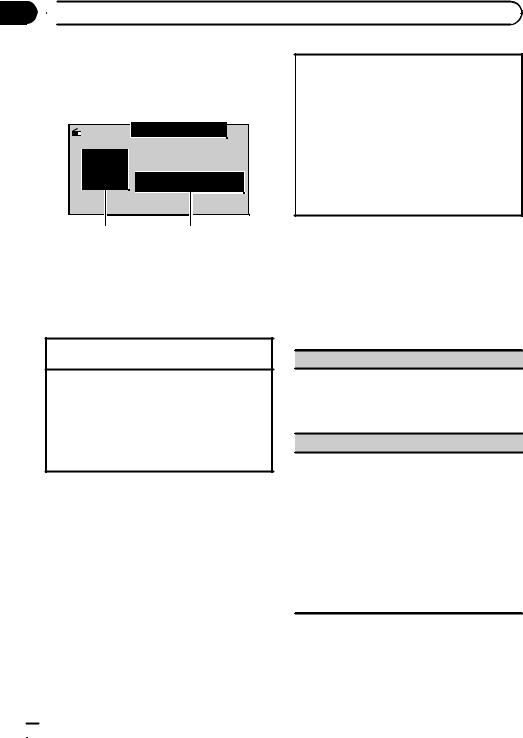
Section
03  Operating this unit
Operating this unit
Radio
Basic Operations
|
|
|
|
1 |
|
|
|
|
||||
|
|
|
|
|
|
|
|
|
|
|
|
16:54 |
|
|
|
|
|
|
|
|
|
|
|
|
|
Radio |
|
Local |
|
|
|
|
|
A-EQ |
|
|
||
|
|
|
|
|
|
|
|
|
|
|
||
|
|
|
|
|
|
|
|
|
|
|||
|
|
|
|
|
|
|
|
|
|
|
|
|
|
|
|
FM1 |
|
P.CH |
|
1 |
|
87.50 |
MHz |
||
|
|
|
|
|
|
|||||||
32
1Indicator display area
Refer to Indicator list on page 38.
2Text information area
!Band/Preset number/Frequency indicator
3Source image display
Manual tuning (step by step) 1 Push M.C. left or right.
Seeking
1Push and hold M.C. left or right, and then release.
You can cancel seek tuning by pushing M.C. left or right.
While pushing and holding M.C. left or right, you can skip stations. Seek tuning starts as soon as you release M.C.
Storing and recalling stations
You can easily store up to six stations for each band as presets.
Using the preset screen
1Push M.C. up or down to display the preset screen.
2Push M.C. up or down until the desired band (FM1, FM2, FM3 for FM or AM) is displayed.
3Use M.C. to store the selected frequency in the memory.
Turn to change the preset number. Press and hold to store.
4Use M.C. to select the desired station.
Turn to change the station. Press to select. You can also display the preset screen by pressing
HOME. Refer to Basic menu operations on page 9.
Function settings
1Press M.C. to display the function menu.
2Turn M.C. to select the function.
After selecting, perform the following procedures to set the function.
BSM (best stations memory)
BSM (best stations memory) automatically stores the six strongest stations in the order of their signal strength.
1Press M.C. to turn BSM on. To cancel, press M.C. again.
Local (local seek tuning)
Local seek tuning lets you tune in to only those radio stations with sufficiently strong signals for good reception.
1Press M.C. to display the setting mode.
2Turn M.C. to select the desired setting.
FM: Off—Level1—Level2—Level3—Level4 AM: Off—Level1—Level2
The larger the setting number, the higher the signal level. The highest level setting allows reception of only the strongest stations; while lower settings let you receive progressively weaker stations.
3Press M.C. to confirm the selection.
 Note
Note
Operation is complete even if the menu is cancelled before being confirmed.
 12
12 En
En
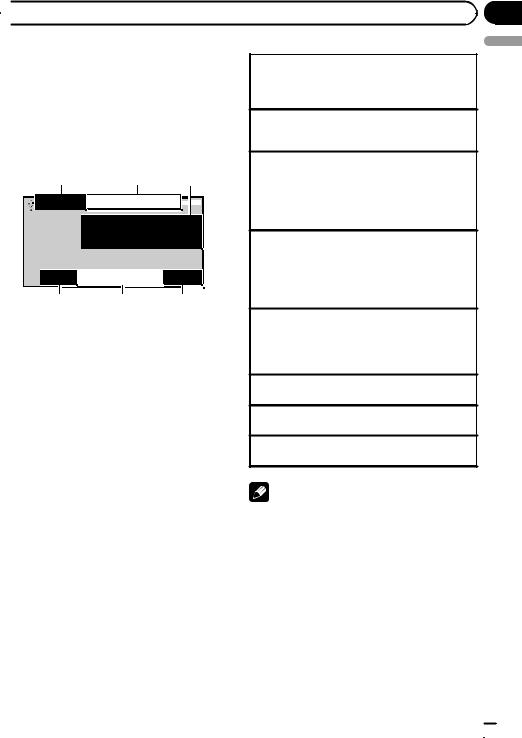
 Operating this unit
Operating this unit
Playing moving images
Basic Operations
If an iPod with video capabilities is connected to this unit using an interface cable such as the CD-IU50V (sold separately), you can enjoy the video contents of the iPod as an iPod source. You need not change the AUX setting.
1 2 3
|
|
|
|
|
|
|
|
|
|
|
|
|
|
2345 |
|
7890 |
|
|
|
|
A-EQ |
|
|
|
16:54 |
Video |
|
|
|
|
|
|
|
|
|
|||
|
|
|
|
|
T |
ext |
|
|
|
|
|
|
 Text
Text
8888'88"  8888'88"
8888'88"
4 5 6
You can switch to the basic screen or the image screen.
Refer to Display (display setting) on page 15.
1File information area for the currently playing file
External storage device (USB, SD)
!Folder/file number indicator iPod
!Song number indicator
2Indicator display area
Refer to Indicator list on page 38.
3Text information area
External storage device (USB, SD)
!Folder name
!File name
iPod
!Song title
!Artist name
!Album title
4 Play time indicator
5 Scrubber bar
6 Remaining time indicator
Section
03
|
|
English |
|
Playing files on a USB storage device |
|||
|
|||
1 |
Open the USB connector cover. |
|
|
2 |
Plug in the USB storage device using a USB |
|
|
|
cable. |
|
|
Stopping playback of files on a USB storage device
1You may disconnect the USB storage device at anytime.
Playing files on an SD memory card
1Remove the front panel.
2Insert an SD memory card into the SD card slot. Insert it with the contact surface facing down and press the card until it clicks and completely locks.
3Re-attach the front panel.
Stopping playback of files on an SD memory card
1Remove the front panel.
2Press the SD memory card until it clicks. The SD memory card is ejected.
3Pull out the SD memory card.
4Re-attach the front panel.
Playing videos on an iPod
1Open the USB connector cover.
2With an interface cable (e.g., CD-IU50V), connect the iPod to a USB cable and AUX input using the iPod Dock Connector.
Selecting a folder
1 Push M.C. up or down.
Selecting a file (chapter) 1 Push M.C. left or right.
Fast forwarding or reversing
1 Push and hold M.C. left or right.
Notes
! USB storage device that can be charged via USB will be recharged when plugged in and the ignition switch is set to ACC or ON.
! Disconnect USB storage devices from the unit when not in use.
! Incompatible text stored with the video image file may not be displayed or may be displayed incorrectly.
! Incompatible text saved on the iPod will not be displayed by the unit.
! If the ignition switch is set to ACC or ON, the iPod battery will be charged while connected.
! Disconnect headphones from the iPod before connecting to this unit.
En  13
13

Section
03  Operating this unit
Operating this unit
!While the iPod is connected to this unit, the iPod cannot be turned on or off unless the control mode is set to iPod.
!The iPod will turn off about two minutes after the ignition switch is set to OFF.
!When playing external storage devices that contain a mixture of various media file types, switch between media file types when playing different files.
Refer to A/V Format (switching media file types) on the next page.
Selecting and playing files from the name list
1 Displaying the list menu.
Refer to Basic menu operations on page 9.
Viewing a list of the files (or folders) in the selected folder
1 When a category is selected, press M.C.
Searching the list by alphabet
1When a list for the selected category is displayed, push and hold M.C. left or right to switch to alphabet search mode.
2Turn M.C. to select a letter.
3Press M.C. to display the alphabetical list.
If alphabet search is aborted, Not Found is displayed.
Changing the name of the video (skip 100 items at once)
1 Push M.C. up or down.
Changing the name of the video (automatically skip 100 items each time)
1 Push and hold M.C. up or down.
2 Use M.C. to select the desired file name (or folder name).
Changing the file or folder name 1 Turn M.C.
Playing
1 When a file is selected, press M.C.
Viewing a list of the files (or folders) in the selected folder
1 When a folder is selected, press M.C.
Changing the file or folder name (skip 100 items at once)
1 Push M.C. up or down.
Changing the file or folder name (automatically skip 100 items each time)
1 Push and hold M.C. up or down.
Browsing for a video on the iPod
1 Displaying the list menu.
Refer to Basic menu operations on page 9.
2 Use M.C. to select a category/video.
Changing the name of the video or category 1 Turn M.C.
Playing
1 When a video is selected, press M.C.
 14
14 En
En
 Note
Note
Depending on the number of files in the iPod, there may be a delay when displaying a list.
Playing DivXâ VOD content
Some DivX VOD (video on demand) content may only be playable a fixed number of times. When you attempt to play back this type of content saved on an external storage device, the remaining number of times it can be played is shown on-screen. You can then decide whether or not to play back the contents of the external storage device.
!If there is no limit to the number of times the DivX VOD content can be viewed, then you may insert the external storage device into your player and play the content as often as you like, and no message will be displayed.
!You can confirm the number of times that the content can be played by checking the number displayed after Remaining Views:.
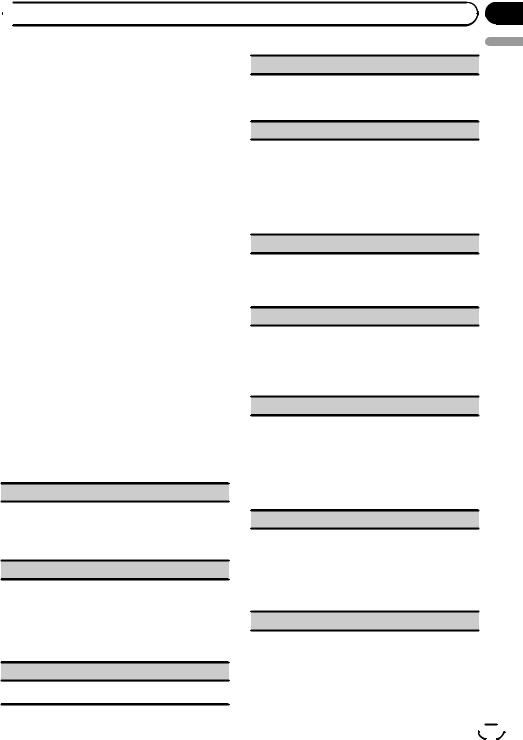
 Operating this unit
Operating this unit
 Important
Important
!In order to play DivX VOD content on this unit, you first need to register the unit with your
DivX VOD content provider. For details on your registration code, refer to Displaying the DivXâ
VOD registration code on page 34.
!DivX VOD content is protected by a DRM (Digital Rights Management) system. This restricts playback of content to specific, registered devices.
% If a message is displayed after inserting the external storage device containing DivX VOD content, use M.C. to select a desired mode.
Turn to change the mode. Press to select.
!Play – Playback of the DivX VOD content
!Next Play – Skip to the next file
!Stop – If you do not want to play the DivX VOD content
Function settings
1Press M.C. to display the function menu.
2Turn M.C. to select the function.
After selecting, perform the following procedures to set the function.
External storage device (USB, SD)
Play/Pause (play/pause)
1Press M.C. to display the setting mode.
2Turn M.C. to select the desired setting.
Play—Pause
3Press M.C. to confirm the selection.
Play Mode (repeat play)
1Press M.C. to display the setting mode.
2Turn M.C. to select a repeat play range.
!All – Repeat all files
!File – Repeat the current file
!Folder – Repeat the current folder
3Press M.C. to confirm the selection.
Stop (stopping playback)
1 Press M.C. to stop playback.
Time Search (time search)
1Press M.C. to display the setting mode.
2Turn M.C. to find the part you want to play.
3Press M.C. to confirm the selection.
Wide Mode (switching the wide mode)
1Press M.C. to display the setting mode.
2Turn M.C. to select the desired setting.
Full (full)—Just (just)—Cinema (cinema)—Zoom (zoom)—Normal (normal)
For details about the settings, refer to Changing the wide screen mode on page 33.
3Press M.C. to confirm the selection.
Display (display setting)
You can switch to the basic screen or the image screen.
1Press M.C. to display the setting mode.
2Press M.C. to select the desired setting.
A/V Format (switching media file types)
1Press M.C. to display the setting mode.
2Turn M.C. to select the desired setting.
Music (compressed audio)—Video (DivX video files)—Photo (JPEG picture files)
3Press M.C. to confirm the selection.
DivX® Subtitle (DivX subtitle file settings)
1Press M.C. to display the setting mode.
2Turn M.C. to select the desired setting.
Original (DivX subtitles) – Custom (DivX external subtitles)
For details about the settings, refer to Setting the DivX subtitle file on page 33.
3Press M.C. to confirm the selection.
TV Aspect (aspect ratio settings)
1Press M.C. to display the setting mode.
2Turn M.C. to select the desired setting.
16 : 9 – Letter Box – Pan Scan
For details about the settings, refer to Setting the aspect ratio on page 33.
3Press M.C. to confirm the selection.
DivX® VOD (DivXâ VOD registration code)
En
Section
03
English
 15
15
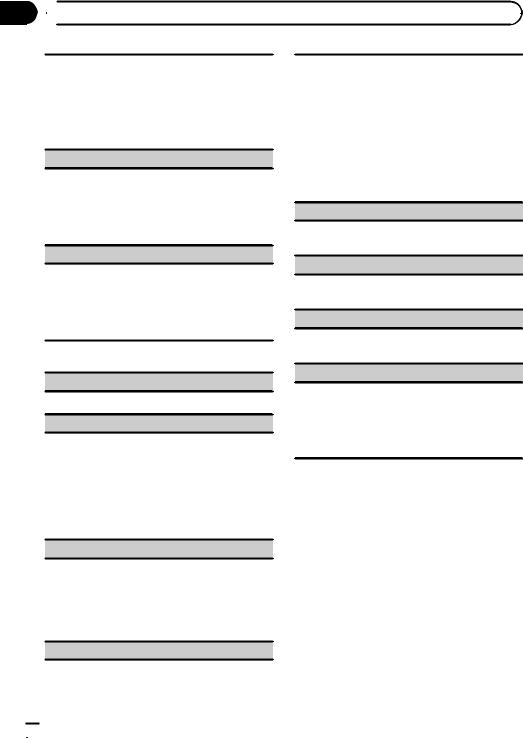
Section
03  Operating this unit
Operating this unit
1Press M.C. to display the setting mode.
2Use M.C. to display the desired code.
Turn to change the menu option. Press to select.
Registration Code - Refer to Displaying the DivXâ VOD registration code on page 34.
Deactivation Code - Refer to Displaying the deactivation code on page 34.
Audio Lang. (audio language settings)
You can switch the audio language during playback when playing a file recorded with dialog in two or more languages.
1Press M.C. to display the setting mode.
2Turn M.C. to select the desired setting.
3Press M.C. to confirm the selection.
Subtitle Lang. (subtitle language settings)
You can switch subtitle language during playback when playing file recorded with subtitles in one or more languages.
1Press M.C. to display the setting mode.
2Turn M.C. to select the desired setting.
3Press M.C. to confirm the selection.
iPod
Pause (pause)
1 Press M.C. to pause or resume.
Shuffle Mode (shuffle)
1Press M.C. to display the setting mode.
2Turn M.C. to select your favorite setting.
!Songs – Play back songs in the selected list in random order.
!Albums – Play back songs from a randomly selected album in order.
!Off – Cancel random play.
3Press M.C. to confirm the selection.
Play Mode (repeat play)
!Refer to Play Mode (repeat play) on the previous page.
However, the repeat range is different from that of external storage devices.
!One – Repeat the current song
!All – Repeat all songs in the selected list
Control Mode (control mode)
This function is not compatible with the following iPod models.
!iPod nano 1st generation
!iPod 5th generation
This unit’s iPod function allows you to conduct operations from your iPod and listen to it using your car’s speakers.
1Press M.C. to select your favorite setting.
!iPod – This unit’s iPod function can be operated from the connected iPod.
!Audio – This unit’s iPod function can be operated from this unit.
Time Search (time search)
!Refer to Time Search (time search) on the previous page.
Wide Mode (switching the wide mode)
!Refer to Wide Mode (switching the wide mode) on the previous page.
Display (display setting)
!Refer to Display (display setting) on the previous page.
ABC Search (alphabet search mode setting)
When this setting is on, you can switch to alphabet search mode by turning M.C. twice while using the browse function of the iPod. Refer to Searching the list by alphabet on page 14.
1Press M.C. to turn the setting for when M.C. is turned twice on or off.
 Notes
Notes
!Operation is complete even if the menu is cancelled before being confirmed.
!Switching the control mode to iPod pauses song playback. Operate the iPod to resume playback.
!The following functions are still accessible from the unit even if the control mode is set to iPod.
—Volume
—Fast forward/reverse
—Track up/down
—Pausing
!When the control mode is set to iPod, operations are limited as follows:
 16
16 En
En
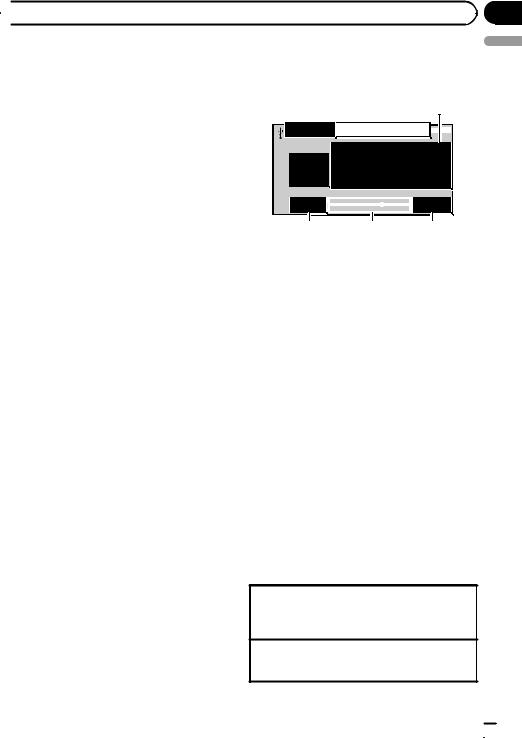
 Operating this unit
Operating this unit
—Only Control Mode (control mode) and Pause (pause) functions are available.
—The browse function cannot be operated from this unit.
!You can select the following functions if the background setting on the entertainment menu is off.
—Wide Mode (switching the wide mode)
—Display (display setting)
—DivX® Subtitle (DivX subtitle file settings)
—TV Aspect (aspect ratio settings)
—Subtitle Lang. (subtitle language settings)
Section
03
Playing audio |
|
|
|
|
|
|
|
English |
|||||||
|
|
|
|
|
|
|
|
||||||||
Basic Operations |
|
|
|
|
|
|
|
|
|||||||
|
1 |
|
|
|
|
|
2 |
|
|
3 |
|
||||
|
|
|
|
|
|
|
|
|
|
|
|
|
|
|
|
|
|
|
|
|
|
|
|
|
|
|
|
|
|
|
|
Music |
2345 |
|
7890 |
|
|
S.Rtrv |
|
|
A-EQ |
|
|
|
16:54 |
|
|
|
|
|
|
Text |
|
|
|
|
|
|
|
|
|
||
|
|
|
|
|
|
|
|
|
|
|
|
|
|
||
|
|
Text |
4 |
|
|
|
|
|
|
|
Text |
8888'88"  -8888'88"
-8888'88"
5 6 7
1File information area for the currently playing file
External storage device (USB, SD)
!Folder/file number indicator iPod
!Song number indicator
2Indicator display area
Refer to Indicator list on page 38.
3Text information area
External storage device (USB, SD)
! Song title/artist name/album title—
folder/file name iPod
!Song title
!Artist name
!Album title
4Artwork/Source image display area iPod
!Artwork display or Source image display
External storage device (USB, SD)
!Source image display
5Play time indicator
6Scrubber bar
7Remaining time indicator
Playing songs on a USB storage device
1Open the USB connector cover.
2Plug in the USB storage device using a USB cable.
Stopping playback of songs on a USB storage device
1You may disconnect the USB storage device at anytime.
En  17
17
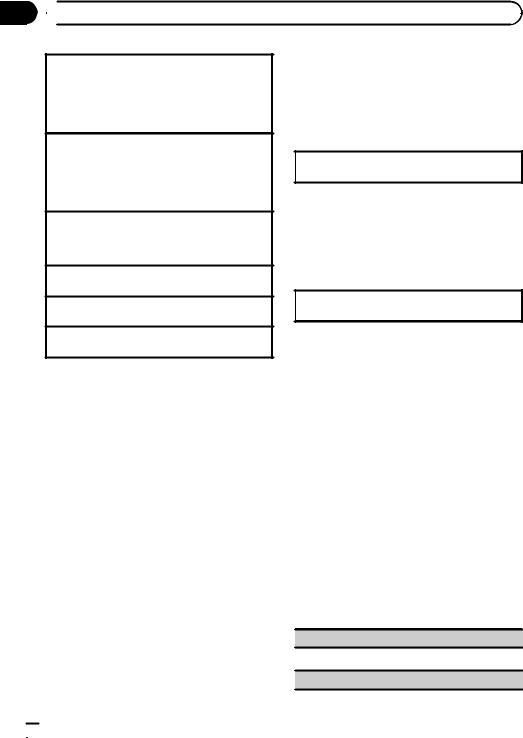
Section
03  Operating this unit
Operating this unit
Playing songs on an SD memory card
1Remove the front panel.
2Insert an SD memory card into the SD card slot. Insert it with the contact surface facing down and press the card until it clicks and completely locks.
3Re-attach the front panel.
Stopping playback of songs on an SD memory card
1Remove the front panel.
2Press the SD memory card until it clicks. The SD memory card is ejected.
3Pull out the SD memory card.
4Re-attach the front panel.
Playing songs on an iPod
1Open the USB connector cover.
2Connect an iPod to the USB cable using an iPod Dock Connector.
Selecting a folder
1 Push M.C. up or down.
Selecting a track (chapter) 1 Push M.C. left or right.
Fast forwarding or reversing
1 Push and hold M.C. left or right.
 Notes
Notes
!USB storage device that can be charged via USB will be recharged when plugged in and the ignition switch is set to ACC or ON.
!Disconnect USB storage devices from the unit when not in use.
!Incompatible text stored with the audio file may not be displayed or may be displayed incorrectly.
!Incompatible text saved on the iPod will not be displayed by the unit.
!If the ignition switch is set to ACC or ON, the iPod battery will be charged while connected.
!Disconnect headphones from the iPod before connecting to this unit.
!While the iPod is connected to this unit, the iPod cannot be turned on or off unless the control mode is set to iPod.
!The iPod will turn off about two minutes after the ignition switch is set to OFF.
Selecting and playing files/ tracks from the name list
Operations are the same as those for moving images. (Refer to Selecting and playing files from the name list on page 14.)
The following operation is available.
Playing a song in the selected folder
1 When a folder is selected, press and hold M.C.
Browsing for a song on the iPod
Operations are the same as those for moving images. (Refer to Browsing for a video on the iPod on page 14.)
The following operation is available.
Playing a song in the selected category
1 When a category is selected, press and hold M.C.
However, the categories in the top tier are different from those for moving images.
!Video (video)
!Playlists (playlists)
!Artists (artists)
!Albums (albums)
!Songs (songs)
!Podcasts (podcasts)
!Genres (genres)
!Composers (composers)
!Audiobooks (audiobooks)
Function settings
1Press M.C. to display the function menu.
2Turn M.C. to select the function.
After selecting, perform the following procedures to set the function.
External storage device (USB, SD)
Pause (pause)
!Press M.C. to pause or resume.
Random (random play)
 18
18 En
En
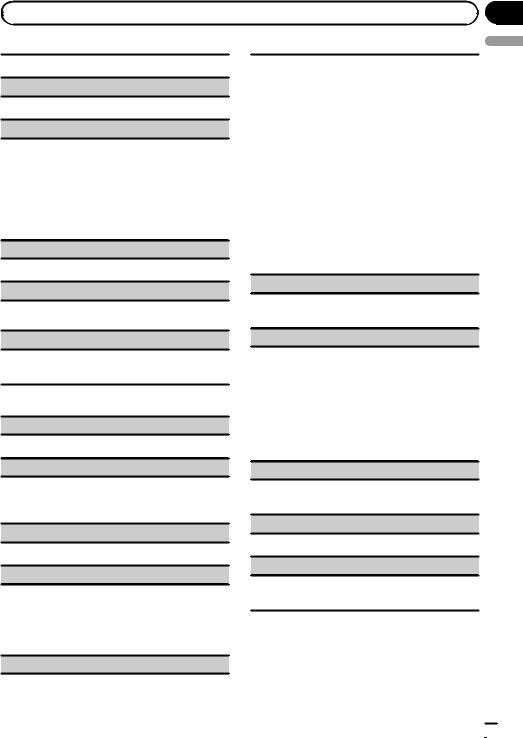
|
Section |
Operating this unit |
03 |
1 Press M.C. to turn random play on or off.
Play Mode (repeat play)
!Refer to Play Mode (repeat play) on page 15.
Sound Retriever (sound retriever)
Automatically enhances compressed audio and restores rich sound.
1Press M.C. to display the setting mode.
2Turn M.C. to select the desired setting.
Off (off)—1—2
1 is effective for low compression rates, and 2 is effective for high compression rates.
3Press M.C. to confirm the selection.
Time Search (time search)
!Refer to Time Search (time search) on page 15.
Display (display setting)
You can play songs from the following lists.
•Album list of the currently playing artist
•Song list of the currently playing album
•Album list of the currently playing genre
1Press M.C. to display the setting mode.
2Turn M.C. to change the mode; press to select.
!Artists – Displays the album list of currently playing artist.
!Albums – Displays a song list from the album currently being played.
!Genres – Displays an album list from the genre currently being played.
3Use M.C. to select an album or song from the list.
For more details about the selection operation, refer to Browsing for a video on the iPod on page 14.
!If no related albums/songs are found, Not Found is displayed.
Control Mode (control mode)
English
You can switch to the desired text information.
!Refer to Display (display setting) on page 15.
A/V Format (switching media file types)
!Refer to A/V Format (switching media file types) on page 15.
iPod
Pause (pause)
!Refer to Pause (pause) on page 16.
Shuffle All (shuffle all)
1Press M.C. to turn shuffle all on.
To turn off, set Shuffle Mode in the Function menu to off.
Shuffle Mode (shuffle)
!Refer to Shuffle Mode (shuffle) on page 16.
Play Mode (repeat play)
!Refer to Play Mode (repeat play) on page 15. However, the repeat range is different from that of external storage devices.
!One – Repeat the current song
!All – Repeat all songs in the selected list
Link Search (link search)
!Refer to Control Mode (control mode) on page 16.
Audiobooks (audiobook speed)
The playback speed of audiobook can be changed.
1Press M.C. to display the setting mode.
2Turn M.C. to select your favorite setting.
!Faster – Playback at a speed faster than normal
!Normal – Playback at normal speed
!Slower – Playback at a speed slower than normal
3Press M.C. to confirm the selection.
Sound Retriever (sound retriever)
!Refer to Sound Retriever (sound retriever) on this page.
Time Search (time search)
!Refer to Time Search (time search) on page 15.
ABC Search (alphabet search mode setting)
!Refer to ABC Search (alphabet search mode setting) on page 16.
 Notes
Notes
!Operation is complete even if the menu is cancelled before being confirmed.
En  19
19
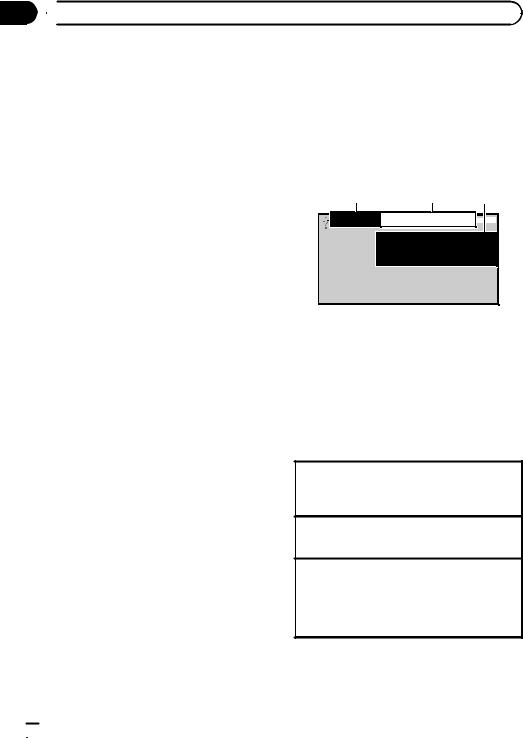
Section
03 Operating this unit
Operating this unit
!Switching the control mode to iPod pauses song playback. Operate the iPod to resume playback.
!The following functions are still accessible from the unit even if the control mode is set to iPod.
—Volume
—Fast forward/reverse
—Track up/down
—Pausing
!When the control mode is set to iPod, operations are limited as follows:
—Only Control Mode (control mode) and Pause (pause) functions are available.
—The browse function cannot be operated from this unit.
Playing still images
When a USB/SD device that contains JPEG picture files is connected, this unit starts a slideshow from the first folder/picture on the device. The player displays the pictures in each folder in alphabetical order.
Basic Operations
1 2 3
|
|
|
|
|
|
|
|
|
|
|
|
2345 |
|
7890 |
|
|
A-EQ |
|
|
|
16:54 |
Photo |
Text |
|
|
|
||||||
 Text
Text
You can switch to the basic screen or the image screen.
Refer to Display (display setting) on the next page.
1Folder/file number indicator
2Indicator display area
Refer to Indicator list on page 38.
3Text information area
!Folder name
!File name
Playing files on a USB storage device
1Open the USB connector cover.
2Plug in the USB storage device using a USB cable.
Stopping playback of files on a USB storage device
1You may disconnect the USB storage device at anytime.
Playing files on an SD memory card
1Remove the front panel.
2Insert an SD memory card into the SD card slot. Insert it with the contact surface facing down and press the card until it clicks and completely locks.
3Re-attach the front panel.
 20
20 En
En
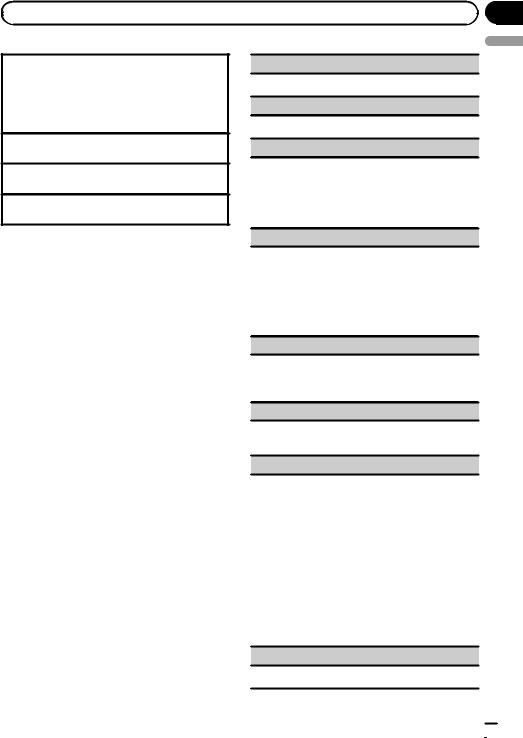
|
Section |
Operating this unit |
03 |
Stopping playback of files on an SD memory card
1Remove the front panel.
2Press the SD memory card until it clicks. The SD memory card is ejected.
3Pull out the SD memory card.
4Re-attach the front panel.
Selecting a folder
1 Push M.C. up or down.
Selecting a file
1 Push M.C. left or right.
Searching every 10 files
1 Push and hold M.C. left or right.
 Notes
Notes
!USB storage device that can be charged via USB will be recharged when plugged in and the ignition switch is set to ACC or ON.
!Disconnect USB storage devices from the unit when not in use.
!Incompatible text stored with the video image file may not be displayed or may be displayed incorrectly.
!When playing external storage devices that contain a mixture of various media file types, switch between media file types when playing different files.
Refer to A/V Format (switching media file types) on the next page.
Pause (pause)
1 Press M.C. to pause or resume.
Random (random play)
!Refer to Random (random play) on page 18.
Play Mode (repeat play)
1Refer to Play Mode (repeat play) on page 15. However, the repeat range is different from that of moving images.
!All – Repeat all files
!Folder – Repeat the current folder
Capture (capturing an image in JPEG files)
You can capture image data and use it as wallpaper. Images can be stored and recalled easily in this unit.
!Only one image can be stored on this unit. Old images are overwritten with the new ones.
1Press M.C. to display the setting mode.
2Turn M.C. to select the desired setting.
3Press M.C. to confirm the selection.
Rotate (picture rotation)
1Press M.C. to display the setting mode.
2Press M.C. to rotate the displayed picture 90° clockwise.
Wide Mode (switching the wide mode)
!Refer to Wide Mode (switching the wide mode) on page 15.
Time Per Slide (slideshow interval time setting)
English
Selecting and playing files from the name list
Operations are the same as those for moving images. (Refer to Selecting and playing files from the name list on page 14.)
Function settings
1Press M.C. to display the function menu.
2Turn M.C. to select the function.
After selecting, perform the following procedures to set the function.
JPEG files can be viewed as a slide show on this unit. In this setting, the interval between each image can be set.
1Press M.C. to display the setting mode.
2Turn M.C. to select the desired setting.
!5sec – JPEG images switch at intervals of 5 seconds
!10sec – JPEG images switch at intervals of 10 seconds
!15sec – JPEG images switch at intervals of 15 seconds
!Manual – JPEG images can be switched manually
3Press M.C. to confirm the selection.
Display (display setting)
!Refer to Display (display setting) on page 15.
En  21
21
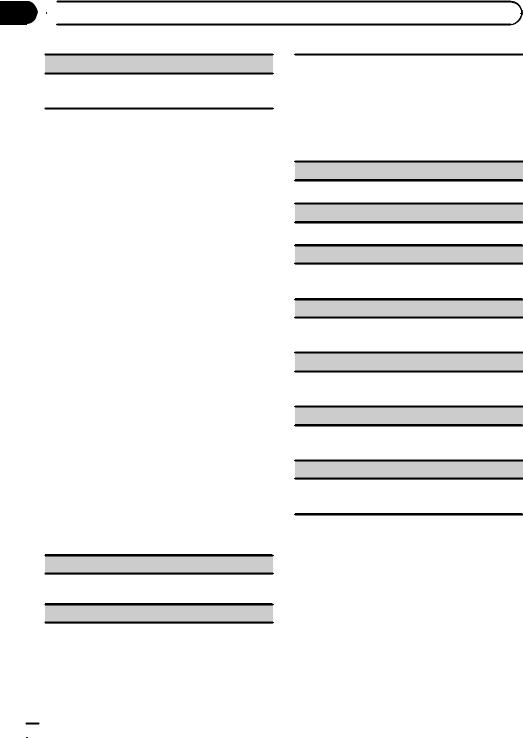
Section
03  Operating this unit
Operating this unit
A/V Format (switching media file types)
!Refer to A/V Format (switching media file types) on page 15.
 Notes
Notes
!Operation is complete even if the menu is cancelled before being confirmed.
!You can select the following functions if the background setting on the entertainment menu is off.
—Capture (capturing an image in JPEG files)
—Rotate (picture rotation)
—Wide Mode (switching the wide mode)
—Display (display setting)
Introduction of operations for playback of still images as a slideshow
1Press M.C. to display the setting mode.
2Select a file.
The following operations are available. The operating method is the same as that for the basic op-
erations. Refer to Basic Operations on page 20.
!Selecting a folder
!Selecting a file
!Searching every 10 files
Pause (pause)
!Refer to Pause (pause) on page 16.
Random (random play)
!Refer to Random (random play) on page 18.
Play Mode (repeat play)
!Refer to Play Mode (repeat play) on the previous page.
Capture (capturing an image in JPEG files)
!Refer to Capture (capturing an image in JPEG files) on the previous page.
You can view still images saved to a USB/SD as a slideshow while listening to audio from another source.
For details about the settings, refer to
Slide Show (slide show viewing) on page 28.
Function settings
1Press M.C. to display the function menu.
2Turn M.C. to select the function.
After selecting, perform the following procedures to set the function.
Return (ending slideshow)
Ending the slideshow.
1 Press M.C. to end the slideshow.
Photo Selection (selecting photos)
Rotate (picture rotation)
!Refer to Rotate (picture rotation) on the previous page.
Wide Mode (switching the wide mode)
!Refer to Wide Mode (switching the wide mode) on the previous page.
Time Per Slide (slideshow interval time setting)
!Refer to Time Per Slide (slideshow interval time setting) on the previous page.
 Note
Note
When the USB or SD source is selected, this unit cannot view still images on USB/SD as a slideshow.
 22
22 En
En

 Operating this unit
Operating this unit
Bluetooth Telephone |
1 |
Press M.C. to display the setting mode. |
|
||
This function is available only for MVH-8250BT. |
2 |
Turn M.C. to select the name of a device you want |
For details on basic operations after connect- |
|
to delete. |
ing to a cellular phone, refer to Using Blue- |
3 |
Press M.C. to select the device you want to delete. |
|
Press and hold M.C. to switch the BD address |
|
tooth telephone on page 11. |
|
|
|
and device name. |
|
! PIN code is set to 0000 as the default. You |
|
|
4 |
Use M.C. to select Yes. |
|
can change this code. Refer to PIN Code |
|
Turn to change the menu option. Press to select. |
(PIN code input) on the next page. |
! |
To cancel, select No. |
|
While this function is in use, do not turn off the |
engine.
Section
03
English
Connection menu operation
 Important
Important
Be sure to park your vehicle in a safe place and apply the parking brake when performing this operation.
1 Display the phone menu.
Refer to Basic menu operations on page 9.
2 Use M.C. to select Connection.
Turn to change the menu option. Press to select.
3 Turn M.C. to select the function.
After selecting, perform the following procedures to set the function.
Device List (connecting or disconnecting a cellular phone from the device list)
1Press M.C. to display the setting mode.
2Turn M.C. to select the name of a device you want to connect.
3Press and hold M.C. to switch the BD address and device name.
4Press M.C. to connect the selected cellular phone.
While connecting, the circular indicator flashes. To complete the connection, check the device name (MVH-8250BT) and enter the link code on your cellular phone. If the connection is established, a circular indicator appears next to the device name.
Delete Device (deleting a cellular phone from the device list)
Add Device (connecting a new cellular phone)
1Press M.C. to start searching.
!To cancel, press M.C. while searching.
2Turn M.C. to select a device from the device list.
!If the desired device is not displayed, select
Search Again.
!If five devices are already paired, Memory Full is displayed and it is not possible to perform this operation. In this case, delete a paired device first.
3Press and hold M.C. to switch the BD address and device name.
4Press M.C. to connect the selected cellular phone.
While connecting, the circular indicator flashes. To complete the connection, check the device name (MVH-8250BT) and enter the link code on your cellular phone. If the connection is established, a circular indicator appears next to the device name.
Special Device (setting a special device)
Bluetooth devices that are difficult to establish a connection with are called special devices. If your Bluetooth device is listed as a special device, select the appropriate one.
1Press M.C. to display the setting mode.
2Use M.C. to select a special device.
Turn to change the menu option. Press to select.
3Use a cellular phone to connect to this unit. While connecting, the circular indicator flashes. To complete the connection, check the device name (MVH-8250BT) and enter the link code on your cellular phone. If the connection is established, a circular indicator appears next to the device name.
!If five devices are already paired, Memory Full is displayed and it is not possible to perform this operation. In this case, delete a paired device first.
En  23
23

Section
03  Operating this unit
Operating this unit
Auto Connect (connecting to a Bluetooth device automatically)
1Press M.C. to turn automatic connection on or off.
Visibility (setting the visibility of this unit)
To check the availability of this unit from other devices, Bluetooth visibility of this unit can be turned on.
1Press M.C. to turn the visibility of this unit on or off.
!While setting Special Device, Bluetooth visibility of this unit is turned on temporarily.
Device Information (BD (Bluetooth device) address display)
1Press M.C. to display the BD address and device name.
PIN Code (PIN code input)
To connect your cellular phone to this unit via Bluetooth wireless technology, you need to enter a PIN code on your phone to verify the connection. The default code is 0000, but you can change it with this function.
1Press M.C. to display the setting mode.
2Turn M.C. to select a number.
3Press M.C. to move the cursor to the next position.
4After inputting the PIN code (up to 8 digits), press
M.C.
The PIN code can be stored in the memory.
!When you press and hold M.C. in the same display, the PIN code you entered is stored in this unit.
!Pressing M.C. in the confirmation display returns you to the PIN code input display, and you can change the PIN code.
Phone menu operation
 Important
Important
Be sure to park your vehicle in a safe place and apply the parking brake when performing this operation.
1 Display the phone menu.
Refer to Basic menu operations on page 9.
 24
24 En
En
2 Turn M.C. to select the function.
After selecting, perform the following procedures to set the function.
Recent (recent call history)
You can make a phone call by selecting from dialed calls, received calls, and missed calls in this menu.
1Press M.C. to display Missed Calls (missed call history), Dialled Calls (dialed call history) or Received Calls (received call history).
2Use M.C. to select the desired list.
Turn to change the menu option. Press to select. To return to the previous display, push M.C. down.
3Press M.C. to make a call.
4When you find a phone number that you want to store in the memory, press and hold M.C. right.
Phone Book (phone book)
!The phone book in your cellular phone will be transferred automatically when the phone is connected to this unit.
!Depending on the cellular phone, the phone book may not be transferred automatically. In this case, operate your cellular phone to transfer the phone
book. The visibility of this unit should be on. Refer to Visibility (setting the visibility of this unit) on this page.
1Press M.C. to display the alphabetical list.
2Turn M.C. to select the first letter of the name you are looking for.
!Press and hold M.C. to select the desired character type.
alphabet–cyrillic alphabet
3Press M.C. to display a registered name list.
4Turn M.C. to select the name you are looking for.
5Press M.C. to display the phone number list.
6Use M.C. to select the phone number you want to call.
Turn to change the phone number. Press to select.
To return to the previous display, push M.C. down.
7Press M.C. to make a call.
8When you find a phone number that you want to store in the memory, press and hold M.C. right.
Preset Dial (preset phone numbers)
1Press M.C. to display the setting mode.
2Use M.C. to select the desired preset number. Turn to change the menu option. Press to select. To return to the previous display, push M.C. down.
3Press M.C. to make a call.
Phone Function (phone function)
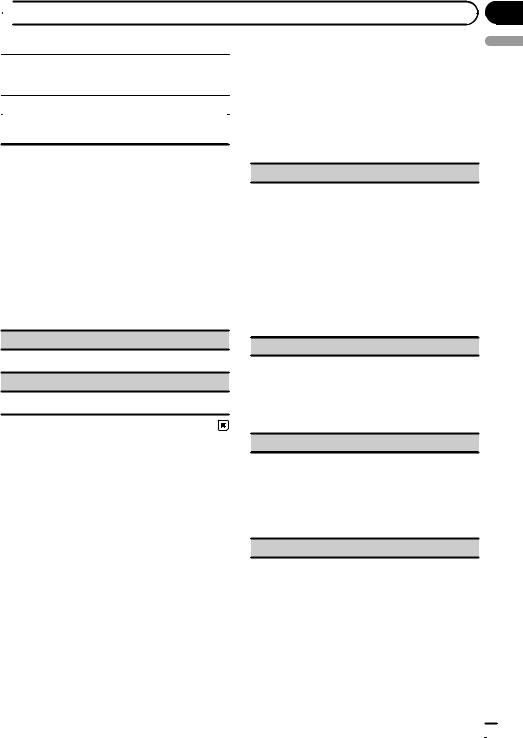
 Operating this unit
Operating this unit
You can set Auto Answer and Ring Tone from this |
Audio Adjustments |
|
menu. For details, refer to Function and operation on |
1 Display the audio menu. |
|
this page. |
||
|
Refer to Basic menu operations on page 9. |
|
Connection (phone connection) |
||
|
||
|
|
Operate the Bluetooth telephone connection menu. Refer to Connection menu operation on page 23.
Function and operation
1 Display Phone Function.
Refer to Phone Function (phone function) on the previous page.
2Press M.C. to display the function menu.
3Turn M.C. to select the function.
After selecting, perform the following procedures to set the function.
Auto Answer (automatic answering)
1 Press M.C. to turn automatic answering on or off.
Ring Tone (ring tone select)
1 Press M.C. to turn the ring tone on or off.
2 Turn M.C. to select the audio function.
After selecting, perform the following procedures to set the audio function.
Fader/Balance (fader/balance adjustment)
1Press M.C. to display the setting mode.
2Push M.C. up or down to adjust the front/rear speaker balance.
Adjustment range (front/rear): Front 15 to Rear 15
3Push M.C. left or right to adjust the left/right speaker balance.
Adjustment range (left/right): Left 15 to Right 15
!Select F/R 0 when only using two speakers.
!When the rear output setting and preout setting are Subwoofer, you cannot adjust front/rear speaker balance.
Sonic Center Control (sonic center control)
Sound that is suited for the listening position can easily be created with this function.
1Press M.C. to display the setting mode.
2Push M.C. left or right to select a listening position.
Adjustment range: Left:7 to Right:7
Auto EQ (auto-equalizer on/off)
The auto-equalizer is an equalizer curve created by auto EQ (refer to Auto EQ (auto-equalizing) on page 30).
You can turn the auto-equalizer on or off.
1 Press M.C. to turn the auto-equalizer on or off. You cannot use this function if auto EQ has not been carried out.
Graphic EQ (equalizer adjustment)
Section
03
English
En  25
25

Section
03  Operating this unit
Operating this unit
You can adjust the currently selected equalizer curve setting as desired. Adjusted equalizer curve settings are stored in Custom1 or Custom2.
!A separate Custom1 curve can be created for each source. If you make adjustments when a curve other than Custom2 is selected, the equalizer curve settings will be stored in Custom1.
!A Custom2 curve that is common for all sources can be created. If you make adjustments when
the Custom2 curve is selected, the Custom2 curve will be updated.
1Press M.C. to display the setting mode.
2Turn M.C. to select an equalizer curve.
Powerful—Natural—Vocal—Custom1—Cus- tom2—Flat—Super Bass
!When Flat is selected no adjustments are made to the sound.
3Push M.C. left or right to select the equalizer band to adjust.
40Hz—80Hz—200Hz—400Hz—1kHz—2.5kHz
—8kHz—10kHz
4Push M.C. up or down to adjust the level of the equalizer band.
Adjustment range: +12dB to –12dB
Loudness (loudness)
Loudness compensates for deficiencies in the lowand high-frequency ranges at low volume.
1Press M.C. to display the setting mode.
2Turn M.C. to select the desired setting.
Off (off)—Low (low)—Mid (mid)—High (high)
3Press M.C. to confirm the selection.
Subwoofer1 (subwoofer on/off setting)
This unit is equipped with a subwoofer output which can be turned on or off.
1 Press M.C. to turn subwoofer output on or off.
Subwoofer2 (subwoofer adjustment)
The cut-off frequency and output level can be adjusted when the subwoofer output is on.
Only frequencies lower than those in the selected range are outputted from the subwoofer.
1Press M.C. to display the setting mode.
2Turn M.C. to select the phase of subwoofer output.
Normal (normal phase)—Reverse (reverse phase)
3Push M.C. up or down to adjust the output level of the subwoofer.
Adjustment range: +6 to -24
4Push M.C. left or right to select the cut-off frequency.
50Hz—63Hz—80Hz—100Hz—125Hz
 26
26 En
En
Bass Booster (bass boost)
1Press M.C. to display the setting mode.
2Turn M.C. to adjust the level. Adjustment range: 0 to +6
3Press M.C. to confirm the selection.
High Pass Filter (high pass filter adjustment)
When you do not want low sounds from the subwoofer output frequency range to play from the front or rear speakers, turn on the HPF (high pass filter). Only frequencies higher than those in the selected range are output from the front or rear speakers.
1Press M.C. to display the setting mode.
2Turn M.C. to select the cut-off frequency.
Off (off)—50Hz—63Hz—80Hz—100Hz—125Hz
3Press M.C. to confirm the selection.
SLA (source level adjustment)
SLA (Source Level Adjustment) lets you adjust the volume level of each source to prevent radical changes in volume when switching between sources.
!When selecting FM as the source, you cannot switch to SLA.
!Settings are based on the FM volume level, which remains unchanged.
Before adjusting source levels, compare the FM volume level with the level of the source you wish to adjust.
!The AM volume level can also be adjusted with
this function.
1Press M.C. to display the setting mode.
2Push M.C. up or down to adjust the source volume.
Adjustment range: +4 to –4
 Notes
Notes
!You cannot select Custom1 and Custom2 when using the auto-equalizer.
!Operation is complete even if the menu is cancelled before being confirmed.
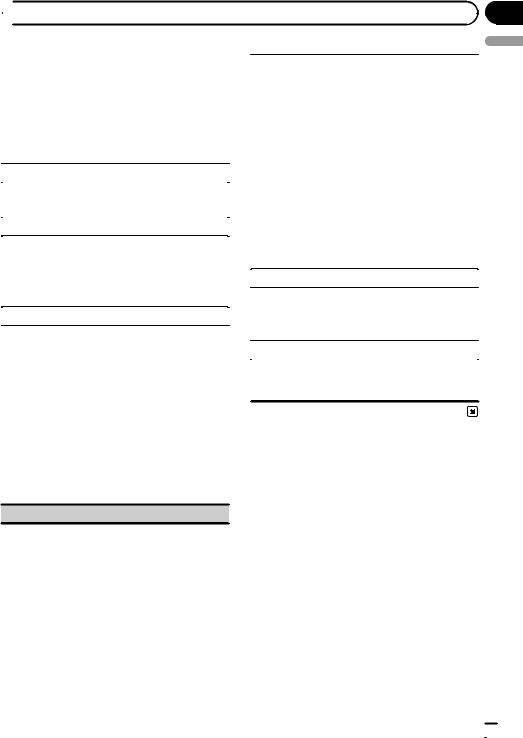
 Operating this unit
Operating this unit
System settings |
|
! |
The language can be changed for the following: |
||
|
|||||
1 Display the system menu. |
|
|
! |
Function menus |
|
Refer to Basic menu operations on page 9. |
|
|
! |
System menu |
|
|
|
! |
Initial menu |
||
|
|
|
|||
2 Turn M.C. to select the system function. |
|
|
! |
On-screen display |
|
|
|
! |
Multi language setting for DivX |
||
After selecting, perform the following proce- |
|
|
|||
! |
If the embedded language and the selected lan- |
||||
dures to set the system function. |
|||||
|
|
guage setting are not the same, text information |
|||
|
|
|
|||
|
|
|
may not be displayed properly. |
||
Guide Info (guide information) |
! |
||||
Some characters may not be displayed properly. |
|||||
1 Press M.C. to display the guide information. |
! |
To complete this operation, switch the ignition key |
|||
|
|
off and on after you set this setting. |
|||
Refer to About guide information on page 10. |
|
|
|||
1 |
Press M.C. to display the setting mode. |
||||
|
|||||
Clock ADJ (date and clock) |
2 |
Turn M.C. to select the desired language. |
|||
|
|
English (English)—Español (Spanish)—Portu- |
|||
|
|
|
|||
1 Press M.C. to display the setting mode. |
|
|
guês (Portuguese)—РУССКИЙ (Russian) |
||
2 Press M.C. to select the segment of the clock dis- |
3 |
Press M.C. to confirm the selection. |
|||
play you wish to set. |
|
Detach Warning (warning tone setting) |
|||
Day—Month—Year—Hour—Minute—AM/PM |
|
||||
|
If the front panel is not detached from the head unit |
||||
3 Turn M.C. to set the date and time. |
|
||||
|
|
within four seconds of turning off the ignition, a warn- |
|||
Picture ADJ (picture adjustment) |
|
||||
|
ing tone sounds. You can turn off the warning tone. |
||||
1 Press M.C. to display the setting mode. |
1 |
Press M.C. to turn warning tone on or off. |
|||
|
|
|
|
||
|
AUX Input (auxiliary input) |
||||
2 Turn M.C. to select the function to be adjusted. |
|
||||
Press to select. |
|
Activate this setting when using an auxiliary device |
|||
Brightness—Contrast—Color—Hue—Dimmer |
|
||||
|
connected to this unit. |
||||
—Temperature—Black Level |
|
||||
1 |
Press M.C. to turn AUX Input on or off. |
||||
|
|||||
For details about the settings, refer to Changing the picture adjustment on page 34.
When you select Black Level, press M.C. to turn the setting on or off.
3 Turn M.C. to increase or decrease the level of the selected item.
Adjustment range: +24 to -24
! Dimmer can be adjusted from +48 to +1.
! Temperature can be adjusted from +3 to –3.
System Lang. (menu language settings)
Section
03
English
En  27
27
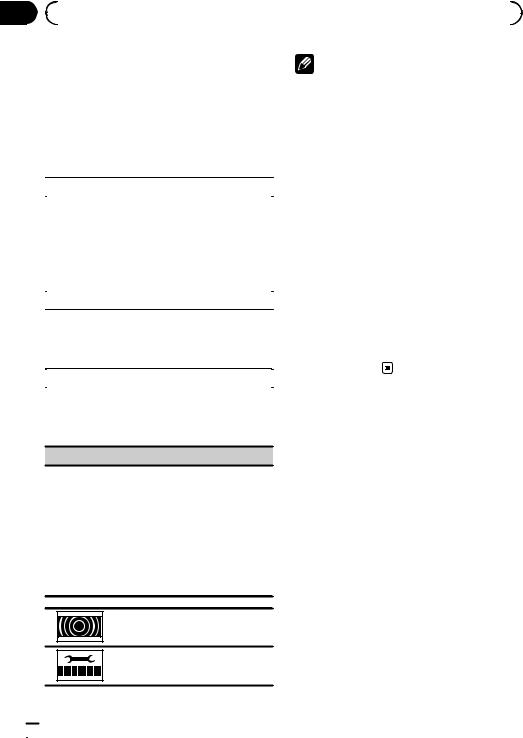
Section |
|
|
|
|
03 |
|
Operating this unit |
|
|
|
Entertainment settings |
Notes |
||
|
1 Display the entertainment menu. |
! If SPEANA (spectrum analyzer) is selected, |
||
|
Refer to Basic menu operations on page 9. |
the spectrum analyzer will be displayed in- |
||
|
2 Turn M.C. to select the entertainment |
stead of Source image display or Artwork dis- |
||
|
play. |
|||
|
function. |
|||
|
! If you select USB, SD as the source, you can- |
|||
|
After selecting, perform the following proce- |
|||
|
not select Slide Show. |
|||
|
dures to set the entertainment function. |
|||
|
|
|
||
|
|
|
Customizing the illumination color |
|
|
Background (background display setting) |
|||
|
1 Press M.C. to display the setting mode. |
1 Use M.C. to select Color Setting in the |
||
|
2 Turn M.C. to select the desired setting. |
Appearance (Illumination color). |
||
|
|
BGP1 (background picture 1)—BGP2 (back- |
Refer to Appearance (screen/illumination |
|
|
|
ground picture 2)—BGP3 (background picture 3) |
color) on this page. |
|
|
|
—BGV (background visual)—Photo (photo)— |
||
|
|
|
|
|
|
|
SPEANA (spectrum analyzer)—Off (display off) |
2 Use M.C. to customize the color. |
|
|
3 Press M.C. to confirm the selection. |
|||
|
Turn for fine tuning. Push left or right to adjust |
|||
|
|
|
||
|
Clock (entertainment clock) |
|||
|
the next color. |
|||
|
1 Press M.C. to turn entertainment clock display on |
3 Press M.C. to store the customized color |
||
|
|
or off. |
in the memory. |
|
|
|
If the setting is on, it is automatically switched to |
||
|
|
The illumination color will be switched to the |
||
|
|
entertainment clock display. |
||
|
|
customized color. |
||
|
|
|
||
|
Slide Show (slide show viewing) |
|||
|
|
|
||
|
|
|
|
|
1Press M.C. to display the setting mode.
2Turn M.C. to select the external storage device. USB (USB storage device)—SD (SD memory card) Slideshow will start.
Appearance (screen/illumination color)
1Press M.C. to display the setting mode.
2Turn M.C. to change the desired screen/illumination color. Press to select.
Screen (screen color)—Illumi (Illumination color)
—Color Setting (customizing color)
For details on Color Setting (customizing color), refer to Customizing the illumination color on this page.
3Turn M.C. to change the desired illumination color. Press to select.
The illumination color changes at a regular interval.
The customized color is set as the illumination color.
 28
28 En
En

 Operating this unit
Operating this unit
Initial Settings |
This unit’s rear output (rear speaker leads output and |
||
1 Press SRC/OFF and hold until the unit |
RCA rear output) can be used for full-range speaker |
||
(Full) or subwoofer (Subwoofer) connection. If you |
|||
turns off. |
|||
switch the rear output setting to Subwoofer, you can |
|||
2 Press M.C. to display the initial setting |
connect a rear speaker lead directly to a subwoofer |
||
without using an auxiliary amp. |
|||
menu. |
Initially, the unit is set for rear full-range speaker con- |
||
|
nection (Full). |
||
3 Turn M.C. to select the initial setting. |
1 |
Press M.C. to display the setting mode. |
|
After selecting, perform the following proce- |
2 |
Turn M.C. to change the setting. |
|
|
Subwoofer (subwoofer)—Full (full-range speak- |
||
dures to set the initial setting. |
|
||
|
er) |
||
|
|
||
|
|
! Even if you change this setting, there is no |
|
FM step (FM tuning step) |
|
||
|
output unless you turn the subwoofer output |
||
The FM tuning step employed by seek tuning can be |
|
on (refer to Subwoofer1 (subwoofer on/off |
|
|
setting) on page 26). |
||
switched between 100 kHz, the preset step, and 50 |
|
||
kHz. |
|
! If you change this setting, subwoofer output |
|
! If seek tuning is performed in 50 kHz steps, sta- |
|
in the audio menu will return to the factory |
|
tions may be tuned in imprecisely. Tune in the sta- |
|
settings. |
|
tions with manual tuning or use seek tuning |
3 |
Press M.C. to confirm the selection. |
|
again. |
Demonstration (demo display setting) |
||
! The tuning step remains at 50 kHz during manual |
|||
|
|
||
tuning. |
1 |
Press M.C. to turn the demo display on or off. |
|
1 Press M.C. to display the setting mode. |
|||
Video Signal (video signal setting) |
|||
2 Turn M.C. to select the FM tuning step. |
|||
100kHz (100 kHz)—50kHz (50 kHz) |
Be sure to adjust the video signal setting to one that |
||
3 Press M.C. to confirm the selection. |
|||
is suitable for your country. |
|||
|
|||
AM step (AM tuning step) |
1 |
Press M.C. to display the setting mode. |
|
The AM tuning step can be switched between 9 kHz, |
2 |
Turn M.C. to select an appropriate video signal. |
|
|
NTSC—PAL |
||
the preset step, and 10 kHz. When using the tuner in |
|
||
3 |
Press M.C. to confirm the selection. |
||
North, Central or South America, reset the tuning |
|||
|
|
||
step from 9 kHz (531 kHz to 1 602 kHz allowable) to 10 |
BT Memory Clear (resetting the Bluetooth wireless |
||
kHz (530 kHz to 1 640 kHz allowable). |
technology module) |
||
1 Press M.C. to display the setting mode. |
This function is available only for MVH-8250BT. |
||
2 Turn M.C. to select the AM tuning step. |
|||
Bluetooth telephone data can be deleted. To protect |
|||
9kHZ (9 kHz)—10kHZ (10 kHz) |
|||
personal information, we recommend deleting this |
|||
3 Press M.C. to confirm the selection. |
|||
data before transferring the unit to other persons. The |
|||
|
|||
A-EQ Measurement (auto-equalizing) |
following settings will be deleted. |
||
The auto-equalizer is an equalizer curve created by |
! |
phone book entries on the Bluetooth telephone |
|
! |
preset numbers on the Bluetooth telephone |
||
auto EQ (refer to Auto EQ (auto-equalizing) on the next |
! |
registration assignment of the Bluetooth tele- |
|
page). |
|||
|
phone |
||
You can turn the auto-equalizer on or off. |
|
||
! |
call history of the Bluetooth telephone |
||
|
|||
Rear Speaker (rear output and subwoofer setting) |
! |
information of the connected Bluetooth telephone |
|
|
! |
PIN code |
|
|
1 |
Press M.C. to display the setting mode. |
|
|
2 |
Use M.C. to select Yes. |
|
|
|
Turn to change the mode. Press to select. |
|
|
|
Cleared is displayed and the settings are deleted. |
|
To cancel, select No.
! While this function is in use, do not turn off the engine.
En
Section
03
English
 29
29

Section
03  Operating this unit
Operating this unit
resulting in battery drainage. Be sure to place
BT Ver. Info. (Bluetooth version display)
the microphone in the specified location.
This function is available only for MVH-8250BT.
1Press M.C. to display the Bluetooth (microprocessor) version of this unit.
Software Update (updating the software)
This function is available only for MVH-8250BT.
This function is used to update this unit with the latest software. For information on the software and updating, refer to our website.
1Press M.C. to display the setting mode.
2Use M.C. to select Yes to show a confirmation display.
Turn to change the mode. Press to select. To cancel, select No.
Follow the on-screen instructions to finish updating the software.
Auto EQ (auto-equalizing)
The auto-equalizer automatically measures the car’s interior acoustic characteristics, and then creates an auto-equalizer curve based on that information.
!To perform this function, dedicated microphone (e.g. CD-MC20) is required.
 WARNING
WARNING
As a loud tone (noise) may be emitted from the speakers when measuring the car's interior acoustic characteristics, never perform auto EQ while driving.
 CAUTION
CAUTION
!Thoroughly check the conditions before performing auto EQ as the speakers may be damaged if these functions are performed when:
—The speakers are incorrectly connected. (For example, when a rear speaker is connected as a subwoofer output.)
—A speaker is connected to a power amp delivering output higher than the speaker’s maximum input power capability.
!If the microphone is placed in an unsuitable position the measurement tone may become loud and measurement may take a long time,
Before operating the auto EQ function
!Carry out auto EQ in as quiet a place as possible, with the car engine and air conditioning switched off. Also cut power to car phones or portable telephones in the car, or remove them from the car before carrying out auto EQ. Sounds other than the measurement tone (surrounding sounds, engine sound, telephones ringing etc.) may prevent correct measurement of the car interior acoustic characteristics.
!Be sure to carry out auto EQ using the optional microphone. Using another microphone may prevent measurement, or result in incorrect measurement of the car interior acoustic characteristics.
!In order to perform auto EQ, the front speaker must be connected.
!When this unit is connected to a power amp with input level control, auto EQ may not be possible if the power amp’s input level is set below the standard level.
!When this unit is connected to a power amp with an LPF, turn this LPF off before performing auto EQ. Also set the cut-off frequency for the built-in LPF of an active subwoofer to the highest frequency.
!The distance has been calculated by computer to be the optimum delay to give accurate results for the circumstances, so please continue to use this value.
—The reflected sound within the car is strong and delays occur.
—The LPF on active subwoofers or external amps delay the lower sounds.
!Auto EQ changes the audio settings as follows:
—The fader/balance settings return to the center position. (Refer to page 25.)
—The equalizer curve switches to Flat. (Refer to page 25.)
 30
30 En
En
